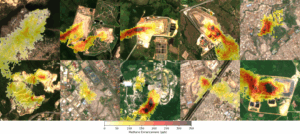Emissions from landfills (waste dumps) are responsible for about 10% of global human-made methane emissions. We have shown we can detect and quantify large landfill methane emissions from space and use the data to support the mitigation of emissions.
We do this by using a combination of satellites (Maasakkers et al., 2022). With TROPOMI, we detect urban hot spots worldwide, which are then used to guide targeted GHGSat observations which zoom-in at 25-m resolution and have shown large emissions coming from individual solid waste disposal sites. These observations can help identify the largest methane emitting landfills worldwide and make their methane emissions visible. Furthermore, the data can support the improvement of emission modeling and be used to pinpoint where within the site emissions are originating. In a recent global satellite survey of 150+ sites using GHGSat data, we found that most emissions are coming from where waste has recently been added to the landfill (Dogniaux et al., 2025). Furthermore, we have evaluated the potential of public hyperspectral satellite data to estimate methane emissions from solid waste disposal sites (Zhang et al., 2025).
Methane emissions from waste are expected to increase with growing population. Hence, there is a clear need to reduce these emissions. In the Targeting Waste emissions Observed from Space (TWOS) project supported by the Global Methane Hub, we use satellites to monitor emission from landfills in ten different cities in the Global South on a monthly basis. We provide this information to local partners, that include jurisdictions, NGOs, development banks, and operators, in support of methane emission mitigation efforts. Through TWOS, we also contribute to the Lowering Organic Waste Methane (LOW-Methane) effort, a global collaboration that supports the mitigation of solid waste methane emissions.





